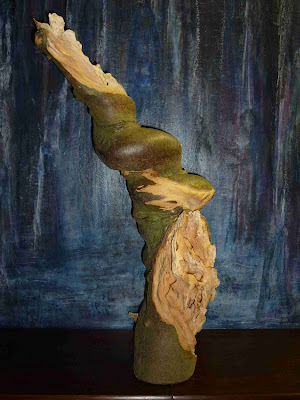Wie Sebastian Sandev es so schön vorgemacht hat, kann die Yamadorisaison so langsam wieder beginnen ;-). Ich war mit Anne in einem Waldgebiet unterwegs, in dem besonders viele große Eichen über Jahrzehnte hinweg immerwieder von den Bauern in der Manier des Zurückschneidens von Kopfweiden, bearbeitet wurden. Dort fanden sich wunderbare Totholzskulpturen aus sehr alten verwitterten Eichenstämmen, die allein schon als Kunstwerke der Natur angesehen werden können. Viele dieser Totholzfragmente haben wir natürlich in unseren Wagen geladen und dann ... ganz plötzlich ... fiel meine Aufmerksamkeit auf diese alte Eiche. Die Bauern hatten, sicher vor Jahrzehnten, einen Eichenstamm abgesägt und ein Seitentrieb übernahm die Funktion eines neuen Stammes. Dieser neue Stamm erreichte mittlerweile eine Höhe von ca. 4,50 Metern, jedoch in seiner Basis hatten sich im Laufe der Jahrzehnte wunderbare, natürliche Schari- und Totholzstrukturen ausgebildet. Meine Entscheidung stand fest ... dieser Baum muss weiterleben ... aber in "betreuter Art und Weise" ;-). Der ursprüngliche Stamm hatte ein sehr beträchtliches Wurzelwerk ausgebildet, so dass es schon einige Mühe kostete, ihn aus dem Boden zu graben. Die Chancen stehen bei 50% dass er es schaffen wird ... man wird sehen ... .Aufgrund seiner skurilen Windungen bekam er spontan den Namen ... Die Kauri-Eiche ... in Anlehnung an die Windungen der Gehäuse der Kaurischnecken.
Like Sebastian Sandev has demonstrated so nicely, the Yamadorisaison can start again slowly ;-). I was on the move with Anne in a woodland, were particularly many big oaks were worked for decades in the manner of cutting back cropped willows by the farmers . There were found miraculous dead wood sculptures from very old weather-beaten oaken trunks which just can be looked as pieces of art-nature . We have loaded of course many of these dead wood fragments in our carriage and then... all of a sudden ... my attention fell on this old oak. The farmers had sawed an oaken trunk off, certainly before decades, and a side branch took over the function of a new trunk. This new trunk reached a height of approx. 4.50 metres, however, in his base natural Schari-and dead wood structures miraculous had set up in the course of decades. My decision was clear ... this tree must live on , but in "looked way";-). The original trunk had build over decades a very substantial rootsystem, so that it cost some trouble to dig it from the ground already . The chances are above 50% that he it will survive ... we'll see.On account of his skuril bends he spontaneously got the name... The Kauri oak... in support of the bends of the cases of the cowries.Como Sebastian Sandev se ha manifestado tan amablemente, Yamadorisaison puede comenzar otra vez despacio ;-). Yo estaba en marcha con Anne en un bosque, eran en particular fueron muchos robles grandes trabajados durante décadas en la manera de la reducción de sauces pacidos por los agricultores. Allí fueron encontrados esculturas de madera muertas milagrosas de muy viejos troncos de roble deteriorados que sólo pueden ser mirados como la naturaleza de las obras de arte. Hemos cargado por supuesto muchos de estos fragmentos de madera muertos en nuestro carro y luego... de repente... mi atención se cayó en este viejo roble. Los agricultores habían aserrado un tronco de roble, seguramente antes de décadas, y una rama de lado asumió la función de un nuevo tronco. Este nuevo tronco alcanzó una altura de aprox. 4.50 metros, sin embargo, en su base natural que las estructuras Schari-y muertas de madera milagrosas hubieran establecido en el curso de décadas. Mi decisión estaba clara... que este árbol debe vivir de, pero "del modo mirado";-). El tronco original tenía construyen a lo largo de las décadas raíces muy sustancial, de modo que él costara un poco de problema para cavarlo de la tierra ya. Las posibilidades están encima del 50 % que él que esto sobrevivirá... veremos. Debido a sus curvas de skuril él espontáneamente consiguió el nombre... El roble Kauri... en apoyo de las curvas de los casos de los cauris (caracol).






















































